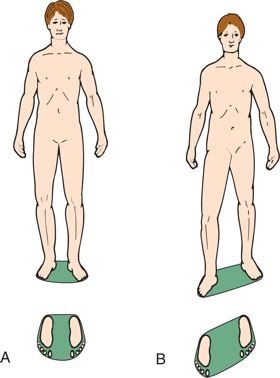Base of Support: Difference between revisions
mNo edit summary |
Kim Jackson (talk | contribs) m (Removed protection from "Base of Support": This is no longer a Plus course page) |
||
| (11 intermediate revisions by 7 users not shown) | |||
| Line 5: | Line 5: | ||
</div> | </div> | ||
== <span>Introduction </span> == | == <span>Introduction </span> == | ||
[[File:BaseOfSupport.jpg|right|frameless]] | |||
The '''base of support (BOS)''' refers to the area beneath an object or person that includes every point of contact that the object or person makes with the supporting surface. These points of contact may be body parts e.g. feet or hands, or they may include things like crutches or the chair a person is sitting in. | The '''base of support (BOS)''' refers to the area beneath an object or person that includes every point of contact that the object or person makes with the supporting surface. These points of contact may be body parts e.g. feet or hands, or they may include things like [[crutches]] or the chair a person is sitting in. | ||
== <span>Significance </span> == | == <span>Significance </span> == | ||
The BOS is an important concept | The BOS is an important concept to understand an individual's ability to [[Balance]], as balance is defined as the ability to maintain the line of gravity (passing through the [[Centre of Gravity]]) within the BOS. | ||
In gait, the base of support has been defined as the horizontal stride width during the double-support phase when both feet are in contact with the ground and the whole-body center of gravity (CG) remains within the BOS.<ref name="krebs">Krebs DE,Goldvasser D,Lockert JD,Portney LG,Gill-Body KM ;Is base of support greater in unsteady gait?:Phys Ther. 2002 Feb;82(2):138-47</ref> A wide base of support (BOS) has long been believed to be a hallmark of unsteady gait. <ref name="nutt">Nutt JG, Marsden CD, Thompson PD. Human walking and higher-level gait disorders, particularly in the elderly. Neurology.1993 ;43:268–279.</ref> | In [[gait]], the base of support has been defined as the horizontal stride width during the double-support phase when both feet are in contact with the ground and the whole-body center of gravity (CG) remains within the BOS.<ref name="krebs">Krebs DE,Goldvasser D,Lockert JD,Portney LG,Gill-Body KM ;Is base of support greater in unsteady gait?:Phys Ther. 2002 Feb;82(2):138-47</ref> A wide base of support (BOS) has long been believed to be a hallmark of unsteady gait. <ref name="nutt">Nutt JG, Marsden CD, Thompson PD. Human walking and higher-level gait disorders, particularly in the elderly. Neurology.1993 ;43:268–279.</ref> | ||
{{#ev:youtube|MGObbsKpbVM}}<br> | {{#ev:youtube|MGObbsKpbVM}}<br> | ||
== Clinical Implication | == Clinical Implication == | ||
| | *A decreased stride width is found to closely correlate with [[Falls|fall]] frequency and dynamic stability.<ref name="krebs" /> | ||
</div> | *The majority of the [[Gait Cycle|gait cycle]] is spent in single leg support during which the BOS is minimized to the width of the supporting foot.<ref name="krebs" /> | ||
== References | *Thus when a patient presents with an unstable gait a wider base of support can be provided by [[Walking Aids|walking aids]] (eg [[Walkers|walker]], crutches, [[Canes|cane]]) giving more stability and a larger BOS. As the condition of the patient improves, the BOS can be reduced.<div class="coursebox"></div> | ||
== References == | |||
<references /> | <references /> | ||
[[Category:Open_Physio]][[Category:Falls]] | [[Category:Open_Physio]] | ||
[[Category:Falls]] | |||
[[Category:Rehabilitation Foundations]] | |||
[[Category:Biomechanics]] | |||
Latest revision as of 09:08, 24 July 2023
Original Editor - The Open Physio project
Top Contributors - Sheik Abdul Khadir, Admin, Rachael Lowe, Kim Jackson, Garima Gedamkar, Simisola Ajeyalemi, Wanda van Niekerk, Scott Buxton, WikiSysop, Claire Knott, Lucinda hampton, Jess Bell and Olajumoke Ogunleye
Introduction [edit | edit source]
The base of support (BOS) refers to the area beneath an object or person that includes every point of contact that the object or person makes with the supporting surface. These points of contact may be body parts e.g. feet or hands, or they may include things like crutches or the chair a person is sitting in.
Significance [edit | edit source]
The BOS is an important concept to understand an individual's ability to Balance, as balance is defined as the ability to maintain the line of gravity (passing through the Centre of Gravity) within the BOS.
In gait, the base of support has been defined as the horizontal stride width during the double-support phase when both feet are in contact with the ground and the whole-body center of gravity (CG) remains within the BOS.[1] A wide base of support (BOS) has long been believed to be a hallmark of unsteady gait. [2]
Clinical Implication[edit | edit source]
- A decreased stride width is found to closely correlate with fall frequency and dynamic stability.[1]
- The majority of the gait cycle is spent in single leg support during which the BOS is minimized to the width of the supporting foot.[1]
- Thus when a patient presents with an unstable gait a wider base of support can be provided by walking aids (eg walker, crutches, cane) giving more stability and a larger BOS. As the condition of the patient improves, the BOS can be reduced.







